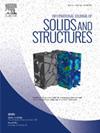Influence of microstructure on the mechanical behavior of open-porous materials under large strains
IF 3.4
3区 工程技术
Q1 MECHANICS
International Journal of Solids and Structures
Pub Date : 2025-05-21
DOI:10.1016/j.ijsolstr.2025.113441
引用次数: 0
Abstract
Open-porous materials are characterized by a complex morphology consisting of an interconnected solid network and voids. The mechanical performance of these materials is strongly governed by their underlying microstructure. This study presents a computational framework to investigate the structure–property relationships in open-porous materials by explicitly modeling the effects of pore-size distribution (PSD), solid fraction, and pore wall geometry. Microstructures with tunable PSDs are generated using Laguerre-Voronoi tessellation based on random closed packing of polydisperse spheres, allowing precise control over pore morphology. A finite element framework with the elastoplastic material model is used to study the macroscopic behavior under compressive loading. The model response is validated against experimental data from aerogel and foam materials. The study reveals that while the solid fraction alone governs the bulk elastic modulus and plastic collapse stress through well-established scaling laws, the PSD critically affects the post-yield behavior, including the plateau and densification regimes under large strains. This study highlights the importance of PSD beyond classical density-based models and provides a predictive design strategy to tailor open-porous materials to application-specific mechanical requirements.
大应变下微观结构对开孔材料力学行为的影响
开孔材料的特点是由相互连接的固体网络和空隙组成的复杂形态。这些材料的机械性能在很大程度上受其底层微观结构的支配。本研究提出了一个计算框架,通过明确模拟孔隙尺寸分布(PSD)、固体分数和孔壁几何形状的影响,来研究开孔材料的结构-性质关系。具有可调谐psd的微结构是基于多分散球体的随机封闭填充使用Laguerre-Voronoi镶嵌生成的,可以精确控制孔隙形态。采用弹塑性材料模型的有限元框架,研究了框架在压缩载荷作用下的宏观性能。通过气凝胶和泡沫材料的实验数据验证了模型的响应。研究表明,虽然固体组分通过完善的标度规律单独控制体弹性模量和塑性崩溃应力,但PSD对屈服后行为(包括大应变下的平台和致密化机制)具有关键影响。该研究强调了PSD在传统的基于密度的模型之外的重要性,并提供了一种预测设计策略,可以根据特定的机械要求定制开孔材料。
本文章由计算机程序翻译,如有差异,请以英文原文为准。
求助全文
约1分钟内获得全文
求助全文
来源期刊
CiteScore
6.70
自引率
8.30%
发文量
405
审稿时长
70 days
期刊介绍:
The International Journal of Solids and Structures has as its objective the publication and dissemination of original research in Mechanics of Solids and Structures as a field of Applied Science and Engineering. It fosters thus the exchange of ideas among workers in different parts of the world and also among workers who emphasize different aspects of the foundations and applications of the field.
Standing as it does at the cross-roads of Materials Science, Life Sciences, Mathematics, Physics and Engineering Design, the Mechanics of Solids and Structures is experiencing considerable growth as a result of recent technological advances. The Journal, by providing an international medium of communication, is encouraging this growth and is encompassing all aspects of the field from the more classical problems of structural analysis to mechanics of solids continually interacting with other media and including fracture, flow, wave propagation, heat transfer, thermal effects in solids, optimum design methods, model analysis, structural topology and numerical techniques. Interest extends to both inorganic and organic solids and structures.

 求助内容:
求助内容: 应助结果提醒方式:
应助结果提醒方式:


